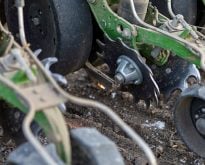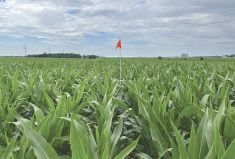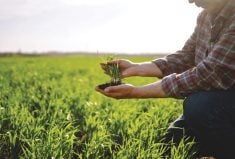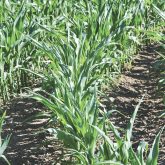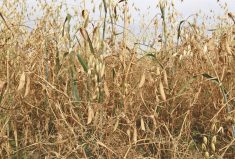A growing contingent from research, agronomy and extension insists that rather than waiting for climate change to happen, agriculture should begin preparing for any contingencies of extreme weather now.
The list of stakeholders is extensive, from university researchers, plant breeders, meteorologists to land-use planners, government bureaucrats, entomologists and plant pathologists. Some are interested in breeding hardier plants to meet growers’ short-term needs while others are examining longer-term soil health or invasive weeds and insects. But the overarching question is what it means to “be prepared” if and when climate change becomes a more pressing reality.
Many agree on three things:
Read Also

Producers aren’t panicking over tariffs and trade threats
The influence of tariff and trade uncertainity on farm business decisions.
One: Waiting for climate change to happen is the wrong approach. Now is the time to address the effects of temperature swings and moisture availability or more extreme weather events.
Two: Those in agriculture need to help those outside the industry build a better foundation of agriculture’s value, economically and for food security.
Three: Greater resilience in plant health and soil health will help reduce risks from climate change.
High ideals
Those are three important goals for University of Guelph weed researcher Clarence Swanton. A member of the Council of Canadian Academies (CCA), Swanton is one of several co-authors of Cultivating Diversity: The Expert Panel on Plant Health Risks in Canada, a 2022 document that assessed current guidelines relating to climate change. It included defining any gaps caused by expected changes in the climate and potential impacts on the agri-food industry.
The Canadian Food Inspection Agency (CFIA) and the Ministry of the Environment and Climate Change (MOECC) were among the agencies requesting the review.
“It’s a high-level report that’s meant to alert government agencies and a general audience to provide an overview of the gaps that have to be addressed to protect plant health as we move forward,” Swanton says, adding that it addresses measures for forestry as much as for agriculture. “It’s not meant to be a text on what we need to do but a text on where the gaps are. We leave the various ministries and public institutions to come up with their own solutions of how they’re going to make it work.”
The group identified three areas of risk: those specific to climate; to pests (weeds, diseases and insects), and to governance. “We’re looking for ways to co-ordinate through policies, through better communications skills about some of these issues that can be addressed at a local, provincial or federal level,” Swanton says. “But I stress that we identify the problems without telling people what they’re supposed to do.”
Whether it’s a municipality, province or the entire country, it’s up to the jurisdiction or industry to decide how or what to implement, such as cover crops, tree planting or water management.
“Even nutrient run-off — if we’re going to have excess water, there are issues related to nutrient movement and once nutrients move, that’s a problem,” Swanton says. “That’s our fundamental problem in agriculture where we have these amazing technologies but by nature, we have to apply it to the environment and once we do that, we start to lose control of it.”
It’s especially challenging with a “farming for today” attitude that allows for only incremental changes from year to year.
The effects of extreme weather have been visible across Canada, including Prairie droughts in 2021 and 2022 and the droughts in Ontario’s Wellington County and Hamilton regions in 2022. Swanton says the effects go beyond lower yields — they affect management practices.
“If you’re forward contracting your corn and wheat and you think these situations are going to become more frequent, what risks are you prepared to take? Even protecting your income by doing some forward contracting is a new variable.”
Five solutions
Swanton says the Cultivating Diversity report offers suggestions for addressing variability caused by climate change. He emphasizes they’re all geared to agricultural production but that none can counteract the weather changes — they can only help reduce risks. They include:
- Intensify crop diversity, including longer rotations.
- Make efforts to increase soil organic matter by leaving crop residue on the surface.
- Control water flow through tile drainage, berms or grassed waterways.
- Intensify cropping systems and diversity of the landscape (with trees) to handle water, heat and energy.
- Keep the soil covered 365 days of the year (if possible).
“We need to plan for extremes,” Swanton says. “If you’re a farmer, you have to think strategically about the long-term change that may occur and what we can do to minimize the risk. Then make the assumption that your soil is the most valuable resource you have and the health of that soil is paramount.”

Regional tendencies
For Tarlok Singh Sahota, climate change is synonymous with “weather uncertainties.” A change from previous norms in long-range weather may provide higher temperatures or rainfall levels. But with extreme heat or moisture comes more uncertainty. In one day in July 2021, the Thunder Bay region saw 50 millimetres of rain within minutes, helping local corn remain productive through the season. But daytime highs above 29 C and nighttime lows above 16 C during the 2021 growing season reduced canola yields in the area.
“At those temperatures, canola flowers and pods will abscise, lowering canola seed yield,” says Sahota, director of the Lakehead University Agricultural Research Station (LUARS). “My aim for our area growers is to get two tonnes (88 bushels) per acre of canola seed yield. Good growers have reached 1.75 tonnes per acre but for weather abnormalities, they could have achieved two tonnes/acre.”
Soil health and resilience can help a lot, and that can be enhanced with manure, longer rotations and diverse cropping systems. Sahota says area farmers have more than a half-dozen crop options, including annuals, perennials, grasses, legumes, and winter and spring oilseeds. He’s also an advocate of Environmentally Smart Nitrogen (ESN), which he’s researched extensively to demonstrate its efficacy in crop production as well as its benefit for nutrient-use efficiency. He acknowledges there’s a lot of work that goes into managing for yield as well as resilience, diversity and environmental protection.
“My greatest concern is that it becomes difficult to plan ahead or that plans don’t really work and must be changed. Crops or varieties tolerant to aberrant weather are surely needed.”
He echoes many of Swanton’s observations and recommendations, including building soil resilience through diversity. At LUARS, he found soil organic matter levels of 3.8 per cent in annually cropped fields versus 5.3 to 5.6 per cent in fields in long-term forage, legumes and grasses.
“This was over 10 years of cropping. Forage grasses and legumes, with small grains, canola and winter crops need to be an integral part of the crop rotations (for the region). A soil with an organic matter of 5.6 per cent will definitely be more resilient and be able to cope with aberrant weather than a soil with 3.8 per cent.”
Sahota says he would like to see good research paired with good extension, meaning researchers doing more work alongside producers. It’s a concept that could help both in the search for measures to reduce the effects of climate change.
The good news is this trend is already underway, with various organizations and ministries engaging in on-farm research. Agriculture and Agri-Food Canada’s (AAFC) Living Lab initiative is an example, where growers learn from researchers on how they conduct trials and plots, while researchers see the challenges growers are facing in their fields.
“When farmers are involved in research and are an integral part in the extension by the researcher, they adopt the new technology or practices quickly, as has been the case at Thunder Bay,” says Sahota. “Farmers will do anything and everything that they’re convinced would work for them.”




